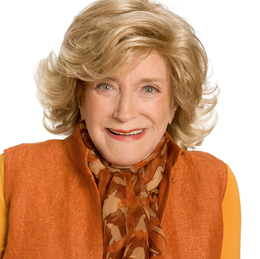
Energetic, needle sharp and committed to reinvention—this is Suzanne Roberts, in all her 93 years. Despite her age, Roberts intends to retain her role as a leader in the arts, education and health care, both in the Philadelphia area and throughout the country.
Roberts has earned multiple Emmys and numerous other awards as creator and host of a nationally broadcast cable TV program called “Seeking Solutions with Suzanne.” Now in its 14th year of production, the show aims to enrich the lives, expand the horizons and broaden the medical knowledge of seniors. She has already filmed more than 2,000 episodes, and she has plenty of new ideas in the hopper.
An ardent supporter of the arts, Roberts’ name is tied to numerous theater and dance companies throughout Philadelphia. (Take, for example, the Suzanne Roberts Theatre along the Avenue of the Arts.) Even so, she is perhaps best known for her philanthropy. Recently, for example, she announced a $2 million gift to Johns Hopkins University to establish the Suzanne Roberts Native American Dream Fund at the school’s Center for American Indian Health. She expects the gift to help create new opportunities for American Indian children as they strive to attain the American dream.
“My mother was very philanthropic,” recalls Roberts, who is the wife of Ralph Roberts, cofounder of Comcast Corp., and the mother of five children, including Brian L. Roberts, current Comcast chairman and CEO. “When I brought a paycheck home, she said to me, ‘You give some of that money back tomorrow; there are others out there who need the money far more than you do.’”
We spoke with Roberts while she was on a winter vacation with her family in Florida. She talked about her love of the arts, her long-running show and the lessons she is now imparting to the next generation. She also shared her goals for 2015 and beyond.
In planning episodes of your show, from where do you draw your inspiration?
The inspirations for my show are from my own life or the lives of those around me. I read a great deal, and I have a great interest in other people—friends, family, strangers who stop me on the street—so I have many ideas for the show. The segments that have really stuck with me are the ones that were real-life experiences for me. I had a cataract removed on camera; I had an endoscopy to remove polyps on camera; I was treated for macular degeneration on camera. I hope going through these things alleviates the fear that might be preventing other people from getting these life-saving procedures.
What are your goals for 2015 and beyond?
They’re very significant. I love doing the show, and I plan on continuing that for as long as I’m wanted. For this coming year I’ve also joined forces with Johns Hopkins University’s Center for American Indian Health. Together we established the Suzanne Roberts Native American Dream Fund, which allows them to continue the amazing work among the Navajo and Apache tribes.
When my five children were small, each summer we would try to find something worthwhile to do as a family. The thinking was that they would receive benefits they would not otherwise have been subjected to. One summer, when my oldest was 17 and my youngest was 7, all five took a trip to a Navajo reservation [in New Mexico], and each child was assigned to be a volunteer in a separate capacity. For myself, I was assigned to the first Navajo hospital that had a psychiatric unit. … Afterward I wished that the family was in a position so we could move [out west] and work with the Navajos. I thought we might get there in due time, but it was not to be a reality. My husband had started his most recent business—a cable television business, which was new at that time—so naturally his wife couldn’t ask him to move the family out west.
I lived with the thought and the dream, and 40-some years later I read about the [Johns Hopkins] Bloomberg School of Public Health and their work with Indians. I was so impressed I contacted them, and they encouraged me to come out and see what was going on. This is how it all came about.
People wonder, at such an old age, why I still have the drive to work rather than be down at the beach with my husband and my family. I like this life of relaxation—of course I enjoy that—but you still do have the drive constantly. This [vacation] is great for a few weeks, but we’ve got to get back and moving and into the things that are significant in my life and my husband’s life. I am still of good health thus far. I am still of good mind thus far. Frankly, we have only one life to live as far as we know, so I think if you have them, you make use of them.
I imagine you’ve learned a lot in 93 years. What lessons are you now imparting to your grandchildren?
I stress the importance of doing work that inspires them, work that they are passionate about, and hopefully doing something in their lives that makes the world a better place.


